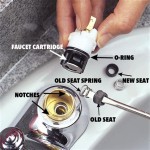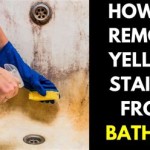Removing Rust Stains From Acrylic Bathtub Surrounds
Acrylic bathtub surrounds offer a durable and aesthetically pleasing option for bathroom design. However, like any material, acrylic can be susceptible to staining, with rust being a particularly stubborn and unsightly culprit. Rust stains, typically resulting from metal objects coming into contact with the acrylic surface in a moist environment, can detract from the overall cleanliness and appearance of the bathroom. Removing these stains requires a careful approach to avoid damaging the acrylic while effectively eliminating the discoloration. This article provides comprehensive guidelines and techniques for effectively removing rust stains from acrylic bathtub surrounds.
Understanding the nature of rust and the properties of acrylic are crucial for selecting the appropriate cleaning methods. Rust, chemically identified as iron oxide, forms when iron or iron alloys are exposed to oxygen and moisture. The resulting oxide adheres to surfaces and can penetrate porous materials. Acrylic, a synthetic polymer renowned for its durability and non-porous surface, is generally resistant to many common cleaning agents. However, harsh chemicals or abrasive materials can scratch or dull the surface, compromising its integrity and appearance. Therefore, the cleaning process must prioritize both stain removal and surface preservation.
Identifying the Source of the Rust Stain
Before embarking on the cleaning process, it is essential to identify and eliminate the source of the rust stain. Common culprits include metal shaving cream cans, rusty shower caddies, or dripping faucets with corroded components. Addressing the source prevents the recurrence of rust stains and maintains the longevity of the acrylic surround. A thorough inspection of the bathroom environment is necessary. Check for any metal objects that are in contact with the acrylic surface, paying particular attention to areas that are frequently exposed to water. Replace rusty shower caddies with plastic or stainless steel alternatives. Repair any dripping faucets or plumbing fixtures to prevent further water damage and corrosion. Consider using rust-inhibiting products on metal surfaces within the bathroom to minimize the risk of future rust formation.
Prevention is always the most effective strategy for dealing with rust stains. Regularly wiping down the acrylic surround after each use can help prevent the buildup of moisture and the formation of rust. Proper ventilation in the bathroom is also crucial to minimize humidity levels. Consider installing or using an exhaust fan during and after showers or baths. Keeping the bathroom clean and dry significantly reduces the chances of rust stains developing on the acrylic surround. Regularly inspecting and maintaining the surrounding surfaces that may contact the acrylic surround will further minimize the likelihood of future incidents.
The location and severity of the rust stain may influence the chosen cleaning method. Fresh stains may be easier to remove than those that have been present for an extended period. Stains located in recessed areas or along seams may require more targeted application and longer dwell times for the cleaning solution. Proper assessment of the stain will guide the selection of the most effective cleaning products and techniques.
Utilizing Mild Cleaning Solutions
The initial approach to removing rust stains from acrylic should involve the use of mild cleaning solutions. These solutions are less likely to damage the acrylic surface while still possessing the ability to lift and dissolve rust deposits. A common and effective mild cleaning solution is a mixture of white vinegar and water. White vinegar contains acetic acid, a mild acid that can break down rust without being overly abrasive. A solution of equal parts white vinegar and water can be applied to the rust stain using a soft cloth or sponge. Allow the solution to dwell on the stain for 15-30 minutes before gently scrubbing with a non-abrasive sponge or cloth. Rinse thoroughly with clean water and dry the surface.
Baking soda, another readily available household item, can also be used as a mild abrasive cleaner. A paste made from baking soda and water can be applied to the rust stain and gently scrubbed with a soft cloth or sponge. Baking soda acts as a gentle abrasive, helping to lift the rust particles from the acrylic surface. After scrubbing, rinse thoroughly with clean water and dry the area. It is important to test any cleaning solution in an inconspicuous area of the acrylic surround before applying it to the entire stain. This will ensure that the solution does not damage or discolor the acrylic surface.
Lemon juice, containing citric acid, is another natural alternative that can be effective in removing rust stains. Similar to vinegar, the citric acid in lemon juice helps to dissolve rust. Apply lemon juice directly to the stain, let it sit for approximately 30 minutes, and then scrub gently with a soft cloth. Rinse thoroughly with water. For best results, use fresh lemon juice as it contains a higher concentration of citric acid. The natural and mild cleaning solution options help to protect the structural integrity of the acrylic while still effectively addressing the discoloration.
Avoid using harsh chemical cleaners such as bleach or ammonia. These chemicals can damage the acrylic surface, causing discoloration, etching, or cracking. Abrasive cleaners, such as scouring powders or steel wool, should also be avoided, as they can scratch the acrylic surface, leading to a dull and unsightly appearance. Choosing appropriate cleaning products and techniques is paramount in maintaining the integrity and aesthetics of the acrylic bathtub surround. Always consult with the manufacturer’s recommendations for approved cleaning products and guidelines.
Employing Specialized Rust Removal Products
If mild cleaning solutions prove ineffective, specialized rust removal products designed for use on acrylic surfaces may be necessary. These products typically contain chemical compounds that are specifically formulated to dissolve rust without harming the acrylic material. When selecting a rust removal product, it is crucial to choose one that is specifically labeled for use on acrylic or plastic surfaces. Read the product label carefully and follow the manufacturer's instructions precisely. Always test the product in an inconspicuous area before applying it to the entire stain. This ensures that the product does not cause any adverse reactions or damage to the acrylic surface.
Many commercially available rust removers are available in liquid or gel form. Gel formulas are often preferred for vertical surfaces, as they adhere to the stain and provide prolonged contact time. Apply the rust remover to the stain according to the manufacturer's instructions. Allow the product to dwell on the stain for the recommended period, then gently scrub with a non-abrasive sponge or cloth. Rinse thoroughly with clean water and dry the surface. In some cases, multiple applications may be necessary to completely remove the rust stain.
For stubborn or deeply ingrained rust stains, consider using a rust stain removing eraser, also known as a melamine sponge. These sponges are made from a micro-abrasive material that can gently lift stains from surfaces. Wet the sponge and gently rub it over the rust stain in a circular motion. Be careful to avoid applying excessive pressure, as this can scratch the acrylic surface. Rinse the area thoroughly with clean water and dry. Melamine sponges are effective for removing a variety of stains, but it is important to use them cautiously and to test them in an inconspicuous area first.
After using any rust removal product, it is essential to thoroughly rinse the treated area with clean water to remove any residual chemicals. Failure to rinse properly can leave behind a residue that may attract dirt or cause discoloration over time. Dry the surface with a clean, soft cloth to prevent water spots and to maintain the shine of the acrylic surround. Proper cleaning and aftercare will help prolong the life of your acrylic bathtub surround and maintain its pristine appearance.

Clean With Me Removing Rust Stains From A Bathtub And Marble Best Cleaning Ever

How To Remove Bath Rust Stains Tapron

Clean With Me Removing Rust Stains From A Bathtub And Marble Best Cleaning Ever

Removing Soap Scum Orange Stains In Shower Surrounds

How To Clean Acrylic Tubs And Shower Walls

How To Remove Rust Stains From Toilets Tubs And Sinks

How To Remove Rust Stains From Tub Merry Maids

How To Clean Acrylic Tubs And Shower Walls
How To Clean Shower Stains Walls Floors Bees Housekeeping

Removing Soap Scum Orange Stains In Shower Surrounds
Related Posts








